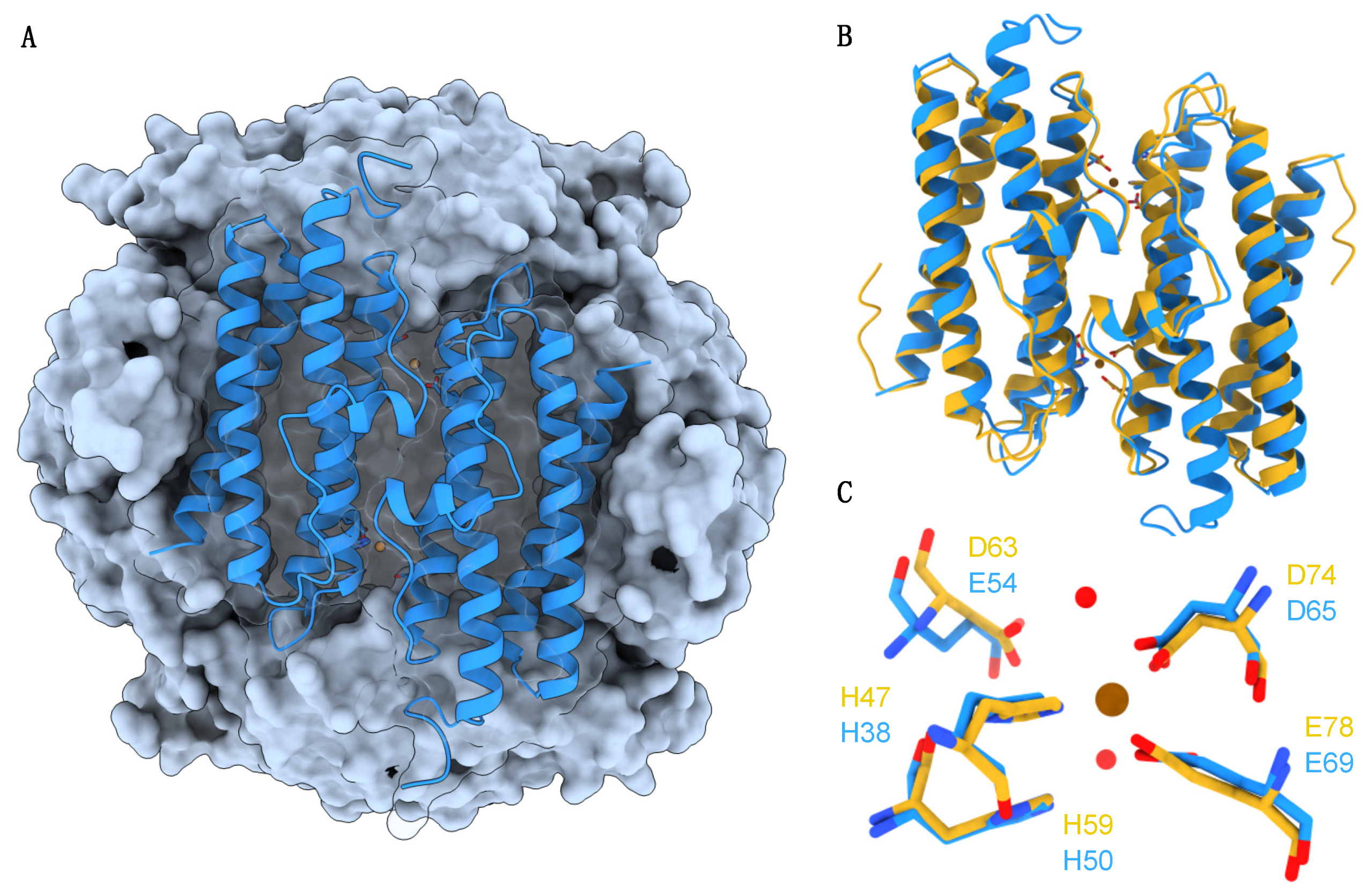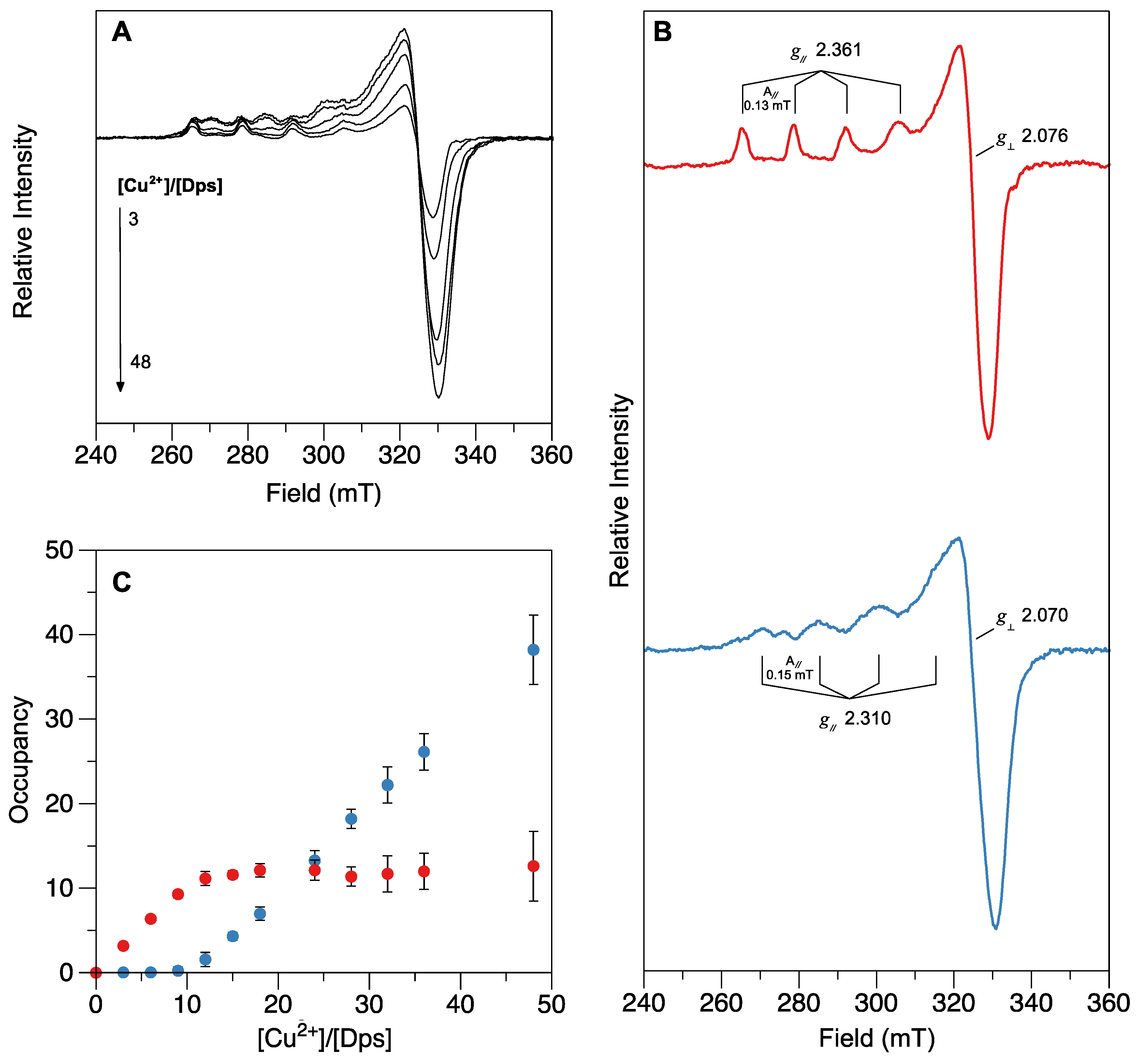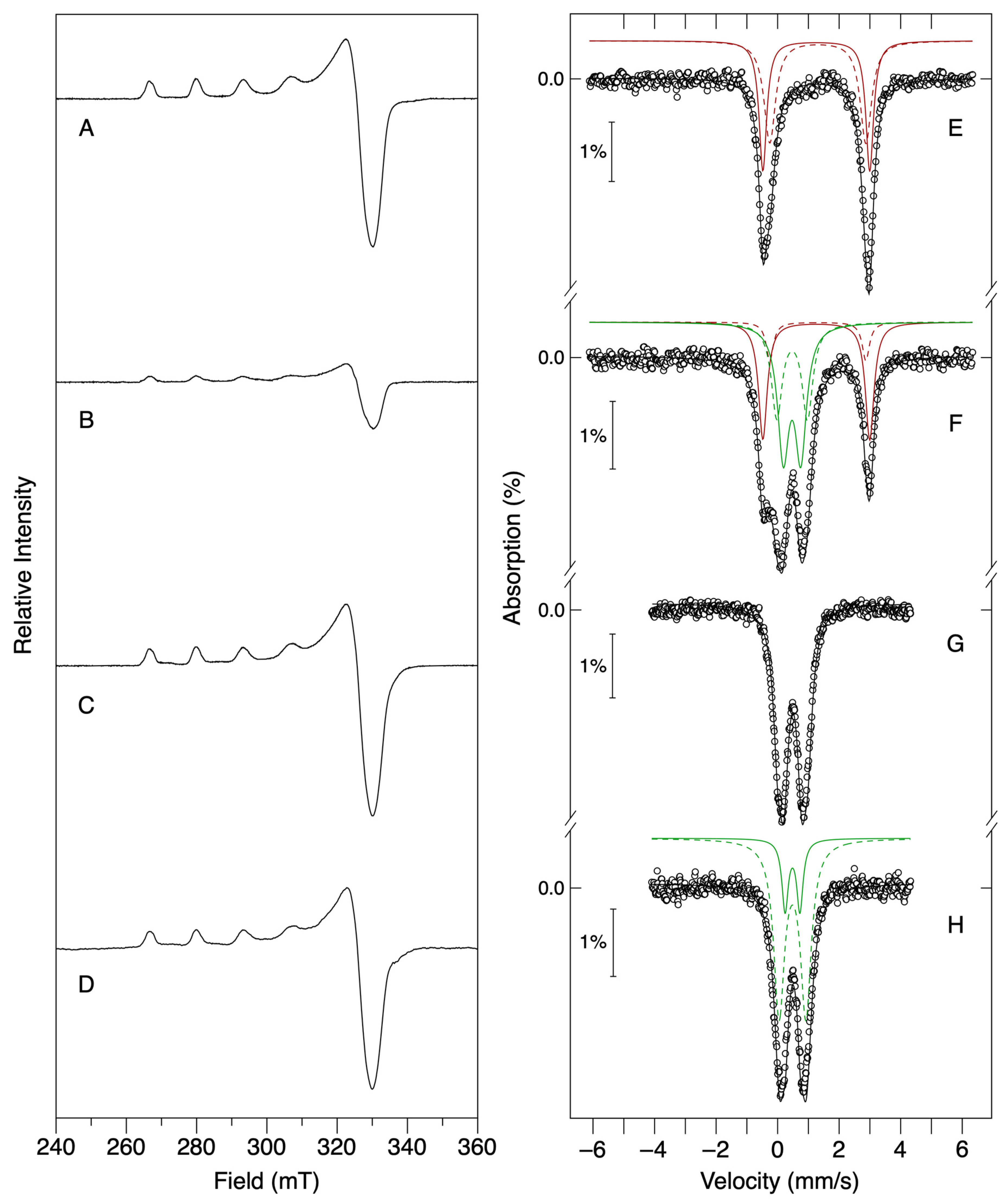Influence of Cupric (Cu2+) Ions on the Iron Oxidation Mechanism by DNA-Binding Protein from Starved Cells (Dps) from Marinobacter nauticus
Abstract
:1. Introduction
2. Results
2.1. Binding of Cupric Ions to Dps
2.2. Effect of Cu2+-Binding on the Iron Mineralization Rate by Dps
2.3. Characterization of the Anaerobic Iron Uptake Reaction in the Presence of Cu2+ Ions
2.4. The Initial Cu2+ State of Copper Is Regenerated in the Presence of an Oxidant Co-Substrate
3. Discussion
4. Materials and Methods
4.1. Production of M. nauticus Dps
4.2. Cu2+ Binding Assays by EPR Spectroscopy
4.3. Iron Uptake Kinetic Assays
4.4. EPR and Mössbauer Spectroscopies Characterization
5. Conclusions
Author Contributions
Funding
Institutional Review Board Statement
Informed Consent Statement
Data Availability Statement
Conflicts of Interest
References
- Crichton, R.R. An Overview of the Role of Metals in Biology. In Practical Approaches to Biological Inorganic Chemistry; Elsevier: Amsterdam, The Netherlands, 2020; pp. 1–16. ISBN 978-0-444-64225-7. [Google Scholar]
- Kruk, J.; Aboul-Enein, H.Y.; Kładna, A.; Bowser, J.E. Oxidative Stress in Biological Systems and Its Relation with Pathophysiological Functions: The Effect of Physical Activity on Cellular Redox Homeostasis. Free Radic. Res. 2019, 53, 497–521. [Google Scholar] [CrossRef]
- Andrews, S.C. Iron Storage in Bacteria. Adv. Microb. Physiol. 1998, 40, 281–351. [Google Scholar] [CrossRef]
- Andrews, S.C.; Robinson, A.K.; Rodríguez-Quiñones, F. Bacterial Iron Homeostasis. FEMS Microbiol. Rev. 2003, 27, 215–237. [Google Scholar] [CrossRef] [PubMed] [Green Version]
- Andrews, S.C. The Ferritin-like Superfamily: Evolution of the Biological Iron Storeman from a Rubrerythrin-like Ancestor. Biochim. Biophys. Acta-Gen. Subj. 2010, 1800, 691–705. [Google Scholar] [CrossRef] [PubMed]
- Guerra, J.P.L.; Jacinto, J.P.; Tavares, P. Miniferritins: Small Multifunctional Protein Cages. Coord. Chem. Rev. 2021, 449, 214187. [Google Scholar] [CrossRef]
- Chiancone, E.; Ceci, P. Role of Dps (DNA-Binding Proteins from Starved Cells) Aggregation on DNA. Front. Biosci. 2010, 15, 122. [Google Scholar] [CrossRef] [Green Version]
- Chesnokov, Y.; Kamyshinsky, R.; Mozhaev, A.; Shtykova, E.; Vasiliev, A.; Orlov, I.; Dadinova, L. Morphological Diversity of Dps Complex with Genomic DNA. Int. J. Mol. Sci. 2023, 24, 8534. [Google Scholar] [CrossRef]
- Dubrovin, E.V.; Dadinova, L.A.; Petoukhov, M.V.; Soshinskaya, E.Y.; Mozhaev, A.A.; Klinov, D.V.; Schäffer, T.E.; Shtykova, E.V.; Batishchev, O.V. Spatial Organization of Dps and DNA–Dps Complexes. J. Mol. Biol. 2021, 433, 166930. [Google Scholar] [CrossRef]
- Williams, S.M.; Chatterji, D. An Overview of Dps: Dual Acting Nanovehicles in Prokaryotes with DNA Binding and Ferroxidation Properties. In Subcellular Biochemistry; Harris, J.R., Marles-Wright, J., Eds.; Subcellular Biochemistry; Springer International Publishing: Cham, Switzerland, 2021; Volume 96, pp. 177–216. ISBN 978-3-030-28150-2. [Google Scholar]
- Gupta, A.; Joshi, A.; Arora, K.; Mukhopadhyay, S.; Guptasarma, P. The Bacterial Nucleoid-Associated Proteins, HU and Dps, Condense DNA into Context-Dependent Biphasic or Multiphasic Complex Coacervates. J. Biol. Chem. 2023, 299, 104637. [Google Scholar] [CrossRef]
- Park, J.H.; Lee, E.S.; Jung, Y.J. Functional Characterization of the DNA-Binding Protein from Starved Cells (DPS) as a Molecular Chaperone under Heat Stress. Biochem. Biophys. Res. Commun. 2023, 667, 180–185. [Google Scholar] [CrossRef]
- Tindall, B.J. Marinobacter nauticus (Baumann et al. 1972) Comb. Nov. Arising from Instances of Synonymy and the Incorrect Interpretation of the International Code of Nomenclature of Prokaryotes. Arch. Microbiol. 2020, 202, 657–663. [Google Scholar] [CrossRef] [PubMed]
- Penas, D.; Pereira, A.S.; Tavares, P. Direct Evidence for Ferrous Ion Oxidation and Incorporation in the Absence of Oxidants by Dps from Marinobacter hydrocarbonoclasticus. Angew. Chem. Int. Ed. 2019, 58, 1013–1018. [Google Scholar] [CrossRef] [PubMed]
- Gauthier, M.J.; Lafay, B.; Christen, R.; Fernandez, L.; Acquaviva, M.; Bonin, P.; Bertrand, J.-C. Marinobacter hydrocarbonoclasticus Gen. Nov., Sp. Nov., a New, Extremely Halotolerant, Hydrocarbon-Degrading Marine Bacterium. Int. J. Syst. Bacteriol. 1992, 42, 568–576. [Google Scholar] [CrossRef] [PubMed] [Green Version]
- Handley, K.M.; Lloyd, J.R. Biogeochemical Implications of the Ubiquitous Colonization of Marine Habitats and Redox Gradients by Marinobacter Species. Front. Microbiol. 2013, 4, 136. [Google Scholar] [CrossRef] [Green Version]
- Grant, R.A.; Filman, D.J.; Finkel, S.E.; Kolter, R.; Hogle, J.M. The Crystal Structure of Dps, a Ferritin Homolog that Binds and Protects DNA. Nat. Struct. Biol. 1998, 5, 294–303. [Google Scholar] [CrossRef]
- Ilari, A.; Stefanini, S.; Chiancone, E.; Tsernoglou, D. The Dodecameric Ferritin from Listeria innocua Contains a Novel Intersubunit Iron-Binding Site. Nat. Struct. Biol. 2000, 7, 38–43. [Google Scholar] [CrossRef]
- Zhao, G.; Ceci, P.; Ilari, A.; Giangiacomo, L.; Laue, T.M.; Chiancone, E.; Chasteen, N.D. Iron and Hydrogen Peroxide Detoxification Properties of DNA-Binding Protein from Starved Cells. J. Biol. Chem. 2002, 277, 27689–27696. [Google Scholar] [CrossRef] [Green Version]
- Yang, X.; Chiancone, E.; Stefanini, S.; Ilari, A.; Chasteen, N.D. Iron Oxidation and Hydrolysis Reactions of a Novel Ferritin from Listeria innocua. Biochem. J. 2000, 349, 783–786. [Google Scholar] [CrossRef] [Green Version]
- Su, M.; Cavallo, S.; Stefanini, S.; Chiancone, E.; Chasteen, N.D. The So-Called Listeria innocua Ferritin Is a Dps Protein. Iron Incorporation, Detoxification, and DNA Protection Properties. Biochemistry 2005, 44, 5572–5578. [Google Scholar] [CrossRef]
- Pesek, J.; Büchler, R.; Albrecht, R.; Boland, W.; Zeth, K. Structure and Mechanism of Iron Translocation by a Dps Protein from Microbacterium arborescens. J. Biol. Chem. 2011, 286, 34872–34882. [Google Scholar] [CrossRef] [Green Version]
- Zeth, K.; Hoiczyk, E.; Okuda, M. Ferroxidase-Mediated Iron Oxide Biomineralization: Novel Pathways to Multifunctional Nanoparticles. Trends Biochem. Sci. 2016, 41, 190–203. [Google Scholar] [CrossRef] [PubMed]
- Bozzi, M.; Mignogna, G.; Stefanini, S.; Barra, D.; Longhi, C.; Valenti, P.; Chiancone, E. A Novel Non-Heme Iron-Binding Ferritin Related to the DNA-Binding Proteins of the Dps Family in Listeria innocua. J. Biol. Chem. 1997, 272, 3259–3265. [Google Scholar] [CrossRef] [PubMed] [Green Version]
- Guerra, J.P.L.; Blanchet, C.E.; Vieira, B.J.C.; Waerenborgh, J.C.; Jones, N.C.; Hoffmann, S.V.; Pereira, A.S.; Tavares, P. Controlled Modulation of the Dynamics of the Deinococcus grandis Dps N-terminal Tails by Divalent Metals. Protein Sci. 2023, 32, e4567. [Google Scholar] [CrossRef] [PubMed]
- Bae, M.K.; Shin, E.; Lee, S.-J. Complementary Roles of Two DNA Protection Proteins from Deinococcus geothermalis. Int. J. Mol. Sci. 2023, 24, 469. [Google Scholar] [CrossRef] [PubMed]
- Ardini, M.; Fiorillo, A.; Fittipaldi, M.; Stefanini, S.; Gatteschi, D.; Ilari, A.; Chiancone, E. Kineococcus radiotolerans Dps Forms a Heteronuclear Mn–Fe Ferroxidase Center That May Explain the Mn-Dependent Protection against Oxidative Stress. Biochim. Biophys. Acta BBA Gen. Subj. 2013, 1830, 3745–3755. [Google Scholar] [CrossRef]
- Hayden, J.A.; Hendrich, M.P. EPR Spectroscopy and Catalase Activity of Manganese-Bound DNA-Binding Protein from Nutrient Starved Cells. J. Biol. Inorg. Chem. 2010, 15, 729–736. [Google Scholar] [CrossRef] [PubMed]
- Haikarainen, T.; Tsou, C.-C.; Wu, J.-J.; Papageorgiou, A.C. Structural Characterization and Biological Implications of Di-Zinc Binding in the Ferroxidase Center of Streptococcus pyogenes Dpr. Biochem. Biophys. Res. Commun. 2010, 398, 361–365. [Google Scholar] [CrossRef] [PubMed]
- Haikarainen, T.; Thanassoulas, A.; Stavros, P.; Nounesis, G.; Haataja, S.; Papageorgiou, A.C.; Haikarainen, T.; Stavros, P.; Papageorgiou, A.C.; Thanassoulas, A. Structural and Thermodynamic Characterization of Metal Ion Binding in Streptococcus suis Dpr. J. Mol. Biol. 2011, 405, 448–460. [Google Scholar] [CrossRef]
- Alaleona, F.; Franceschini, S.; Ceci, P.; Ilari, A.; Chiancone, E. Thermosynechoccus elongatus DpsA Binds Zn(II) at a Unique Three Histidine-Containing Ferroxidase Center and Utilizes O2 as Iron Oxidant with Very High Efficiency, Unlike the Typical Dps Proteins. FEBS J. 2010, 277, 903–917. [Google Scholar] [CrossRef]
- Stefanini, S.; Cavallo, S.; Montagnini, B.; Chiancone, E. Incorporation of Iron by the Unusual Dodecameric Ferritin from Listeria innocua. Biochem. J. 1999, 338, 71–75. [Google Scholar] [CrossRef]
- Havukainen, H.; Haataja, S.; Kauko, A.; Pulliainen, A.T.; Salminen, A.; Haikarainen, T.; Finne, J.; Papageorgiou, A.C. Structural Basis of the Zinc- and Terbium-Mediated Inhibition of Ferroxidase Activity in Dps Ferritin-like Proteins. Protein Sci. 2008, 17, 1513–1521. [Google Scholar] [CrossRef] [PubMed] [Green Version]
- Howe, C.; Moparthi, V.K.; Ho, F.M.; Persson, K.; Stensjö, K. The Dps4 from Nostoc punctiforme ATCC 29133 Is a Member of His-Type FOC Containing Dps Protein Class That Can Be Broadly Found among Cyanobacteria. PLoS ONE 2019, 14, e0218300. [Google Scholar] [CrossRef] [PubMed] [Green Version]
- Festa, R.A.; Thiele, D.J. Copper: An Essential Metal in Biology. Curr. Biol. 2011, 21, R877–R883. [Google Scholar] [CrossRef] [PubMed] [Green Version]
- Biasini, M.; Bienert, S.; Waterhouse, A.; Arnold, K.; Studer, G.; Schmidt, T.; Kiefer, F.; Cassarino, T.G.; Bertoni, M.; Bordoli, L.; et al. SWISS-MODEL: Modelling Protein Tertiary and Quaternary Structure Using Evolutionary Information. Nucleic Acids Res. 2014, 42, 252–258. [Google Scholar] [CrossRef]
- Guerra, J.P.L.; Blanchet, C.E.; Vieira, B.J.C.; Almeida, A.V.; Waerenborgh, J.C.; Jones, N.C.; Hoffmann, S.V.; Tavares, P.; Pereira, A.S. The Conformation of the N-Terminal Tails of Deinococcus grandis Dps Is Modulated by the Ionic Strength. Int. J. Mol. Sci. 2022, 23, 4871. [Google Scholar] [CrossRef]
- Elwell, C.E.; Gagnon, N.L.; Neisen, B.D.; Dhar, D.; Spaeth, A.D.; Yee, G.M.; Tolman, W.B. Copper–Oxygen Complexes Revisited: Structures, Spectroscopy, and Reactivity. Chem. Rev. 2017, 117, 2059–2107. [Google Scholar] [CrossRef] [Green Version]
- Solomon, E.I.; Heppner, D.E.; Johnston, E.M.; Ginsbach, J.W.; Cirera, J.; Qayyum, M.; Kieber-Emmons, M.T.; Kjaergaard, C.H.; Hadt, R.G.; Tian, L. Copper Active Sites in Biology. Chem. Rev. 2014, 114, 3659–3853. [Google Scholar] [CrossRef] [Green Version]
- Yalovega, G.E.; Myasoedova, T.N.; Shmatko, V.A.; Brzhezinskaya, M.M.; Popov, Y.V. Influence of Cu/Sn Mixture on the Shape and Structure of Crystallites in Copper-Containing Films: Morphological and X-Ray Spectroscopy Studies. Appl. Surf. Sci. 2016, 372, 93–99. [Google Scholar] [CrossRef]
- Waerenborgh, J.C.; Tavares, P.; Pereira, A.S. Mössbauer Spectroscopy. In Radiation in Bioanalysis; Pereira, A.S., Tavares, P., Limão-Vieira, P., Eds.; Bioanalysis; Springer International Publishing: Cham, Switzerland, 2019; Volume 8, pp. 213–244. ISBN 978-3-030-28246-2. [Google Scholar]
- Zeth, K.; Sancho-Vaello, E.; Okuda, M. Metal Positions and Translocation Pathways of the Dodecameric Ferritin-like Protein Dps. Inorg. Chem. 2019, 58, 11351–11363. [Google Scholar] [CrossRef]
- Zeth, K.; Pretre, G.; Okuda, M. Time-Resolved Studies of Ytterbium Distribution at Interfacial Surfaces of Ferritin-like Dps Protein Demonstrate Metal Uptake and Storage Pathways. Biomedicines 2021, 9, 914. [Google Scholar] [CrossRef]
- Arnaud, S.; Malatesta, F.; Guigliarelli, B.; Gayda, J.-P.; Bertrand, P.; Miraglio, R.; Denis, M. Purification and Characterization of the Oxidase from the Marine Bacterium Pseudomonas nautica 617. Eur. J. Biochem. 1991, 198, 349–356. [Google Scholar] [CrossRef] [PubMed]
- Denis, M.; Arnaud, S.; Malatesta, F. Hydrogen Peroxide Is the End Product of Oxygen Reduction by the Terminal Oxidase in the Marine Bacterium Pseudomonas nautica 617. FEBS Lett. 1989, 247, 475–479. [Google Scholar] [CrossRef] [Green Version]
- Säbel, C.E.; Neureuther, J.M.; Siemann, S. A Spectrophotometric Method for the Determination of Zinc, Copper, and Cobalt Ions in Metalloproteins Using Zincon. Anal. Biochem. 2010, 397, 218–226. [Google Scholar] [CrossRef] [PubMed]
- Aasa, R.; Vänngård, T. EPR Signal Intensity and Powder Shapes: A Reexamination. J. Magn. Reson. 1969 1975, 19, 308–315. [Google Scholar] [CrossRef]




| [Fe2+]/[Dps] | Initial Velocity (∆Abs/min) | |
|---|---|---|
| Apo-Dps | 12 Cu2+-Dps | |
| 48 | 0.003 ± 0.001 | 0.031 ± 0.002 |
| 96 | 0.006 ± 0.002 | 0.074 ± 0.002 |
| 192 | 0.015 ± 0.003 | 0.161 ± 0.005 |
| 288 | 0.028 ± 0.003 | 0.231 ± 0.009 |
| 384 | 0.064 ± 0.004 | 0.290 ± 0.012 |
| Iron Species | Mössbauer Parameters | Absorption (%) | ||||
|---|---|---|---|---|---|---|
| δ (mm/s) | ∆EQ (mm/s) | Linewidth (mm/s) | 12 57Fe2+ | 12 57Fe2+ + 12 Cu2+ | 12 57Fe2+ + 12 Cu2+ + 24 H2O2 | |
| Ferrous species | ||||||
| I | 1.26 ± 0.02 | 3.48 ± 0.02 | 0.30 ± 0.02 | 46 ± 2 | 22 ± 3 | − |
| II | 1.30 ± 0.02 | 3.12 ± 0.03 | 0.38 ± 0.03 | 54 ± 2 | 13 ± 3 | − |
| Ferric species | ||||||
| III | 0.48 ± 0.02 | 0.61 ± 0.02 | 0.38 ± 0.03 | − | 44 ± 3 | 62 ± 2 |
| IV | 0.48 ± 0.02 | 1.01 ± 0.02 | 0.38 ± 0.02 | − | 21 ± 3 | 38 ± 2 |
Disclaimer/Publisher’s Note: The statements, opinions and data contained in all publications are solely those of the individual author(s) and contributor(s) and not of MDPI and/or the editor(s). MDPI and/or the editor(s) disclaim responsibility for any injury to people or property resulting from any ideas, methods, instructions or products referred to in the content. |
© 2023 by the authors. Licensee MDPI, Basel, Switzerland. This article is an open access article distributed under the terms and conditions of the Creative Commons Attribution (CC BY) license (https://creativecommons.org/licenses/by/4.0/).
Share and Cite
Guerra, J.P.L.; Penas, D.; Tavares, P.; Pereira, A.S. Influence of Cupric (Cu2+) Ions on the Iron Oxidation Mechanism by DNA-Binding Protein from Starved Cells (Dps) from Marinobacter nauticus. Int. J. Mol. Sci. 2023, 24, 10256. https://doi.org/10.3390/ijms241210256
Guerra JPL, Penas D, Tavares P, Pereira AS. Influence of Cupric (Cu2+) Ions on the Iron Oxidation Mechanism by DNA-Binding Protein from Starved Cells (Dps) from Marinobacter nauticus. International Journal of Molecular Sciences. 2023; 24(12):10256. https://doi.org/10.3390/ijms241210256
Chicago/Turabian StyleGuerra, João P. L., Daniela Penas, Pedro Tavares, and Alice S. Pereira. 2023. "Influence of Cupric (Cu2+) Ions on the Iron Oxidation Mechanism by DNA-Binding Protein from Starved Cells (Dps) from Marinobacter nauticus" International Journal of Molecular Sciences 24, no. 12: 10256. https://doi.org/10.3390/ijms241210256







